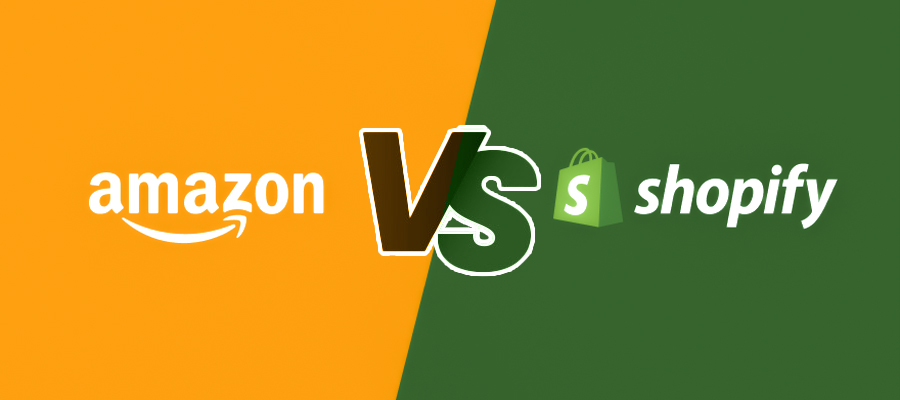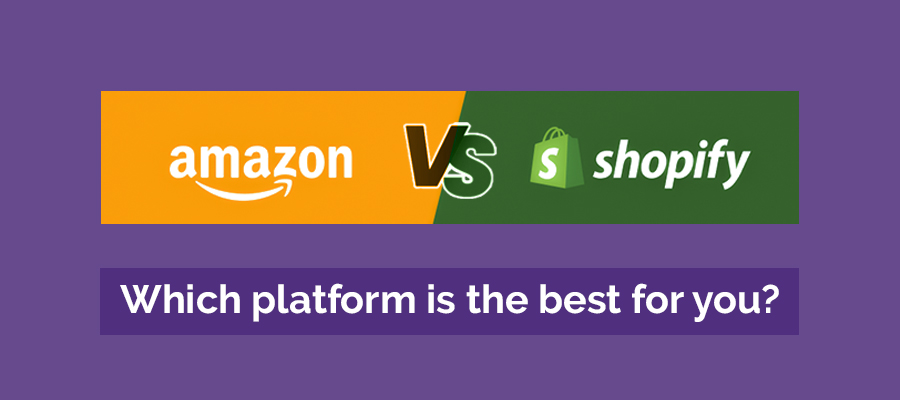
Wondering which platform to choose between Shopify vs Amazon! This article carries out a comprehensive comparison that will help you to make an informed decision. It is one of the best sides to side comparison between Amazon and Shopify that you can find online.
It is good to look at how services stack up across ease of use, pros and cons, design and flexibility, ecommerce tools and features, payment methods and fees, help and support, and pricing plan. However, it is good to have an overview of these two platforms before going deeper into the discussion.
Contents
Shopify Overview

Shopify is a platform that boasts of having more than one million users. It makes it one of the most popular hosted ecommerce solutions in the market. The tool has gained its reputation for being beginner friendly. It gives retailers who have no development or coding experience an opportunity to manage and build a professional store with unlimited products.
The solution is easy to set up, ready to go, and highly affordable. The basic package of Shopify has certain features that you will pay for on the other platforms. There are Shopify free themes available as well. It is a fully-hosted model ecommerce platform that comes your way at very reasonable prices.
It has an intuitive content management system, site builder, high quality templates, and great features even in the basic package. The platform offers 24/7 support and a very active online community. If you own a medium or small-size store, this is a tool that you can fully rely upon.
Shopify also has omnichannel selling for Amazon and social media, and free SSL certificate, discount to offer value to customers. Retailers that use Spotify shipping also get shipping discounts. However, before you start using Shopify, make sure you confirm the cost of utilizing 3rd party gateways. Also, make sure that you have the ability of making backend changes if you feel that you will need that at some point.
Shopify is a great tool for starters. It will also serve you perfectly if you are transitioning from a medium or small-size store into a new eCommerce platform.
Shopify Pros & Cons
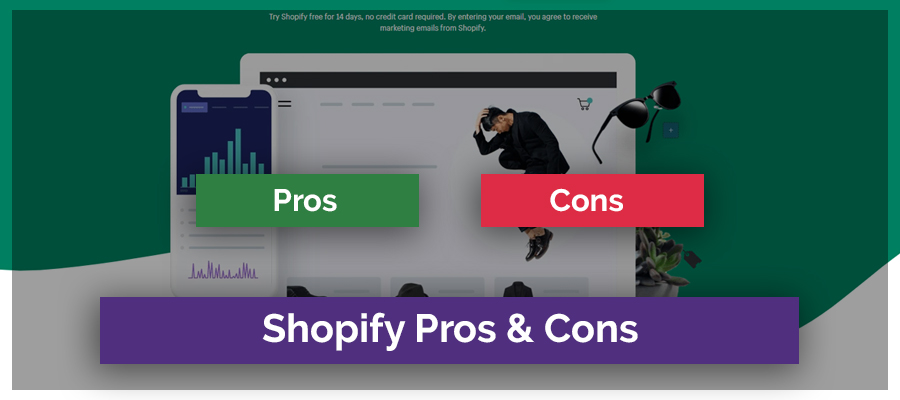
Pros
- An extensive set if features on all the plans
- Great-design templates
- Fully-hosted platform that is easy to manage and set up
Cons
- Making backend code changes is very difficult
- Using third-party payment gateways costs extra. Only accepts free Shopify payments
Amazon Overview

Amazon offers an in-house fulfillment service for its sellers. Instead of taking care of the delivery and storage of the products by themselves, sellers can use the logistics networks and warehouses of Amazon. It significantly reduces the administrative and financial burden to the seller.
It is worth noting that this is an additional service that you get as an Amazon seller. It only meets the needs of those people who purpose to sell their products on Amazon. It isn’t a self-contained ecommerce platform that allows sellers to list several products and retain all the revenue that comes from the sales. Amazon takes a big chuck of what comes from the sales. You also compete with the other individuals who are selling in the same marketplace.
Several benefits come with getting access to the biggest single retail market globally. However, you need to compare this with the high levels of competition, limited control, and hefty fees that come with this platform.
If you are a small retailer who does not have the capacity to deal with the hassles of managing an ecommerce store, you will find Amazon to be highly useful. It can also help retailers who have established stores and wish to introduce their products to a broad market.
You need a unique set of skills to run a successful business on Amazon. It is very different from running a traditional eCommerce store. You need to learn several topics including results page optimization, product page optimization, keyword analysis, competitor research etc.
The platform has really helped Amazon to open up its marketplace to new sellers. It has also streamlined the process of fulfilling purchases and storing items that is often a complex one. For starters, running an independent store is a daunting task making Amazon a viable option.
Amazon Pros & Cons
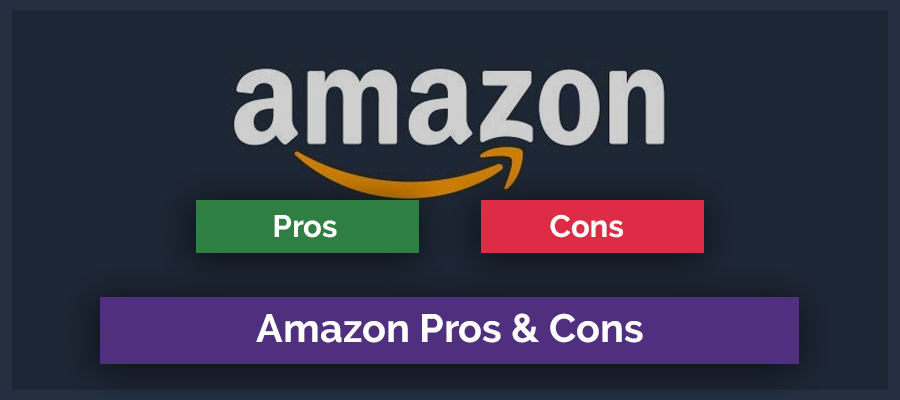
Pros
- It is not necessary to run your personal eCommerce store
- Limited administrative and logistical burden
- Access to the biggest retail marketplaces in the whole world
Cons
- Startup costs for initial order are relatively high
- No control over the design of products
- High fulfillment and listing fees
Ease Of Use: Shopify vs Amazon

Ease of use comes as a top comparison criterion between Shopify vs Amazon. The reason is that it is among the most important considerations when looking for an eCommerce platform. You don’t want to use a lot of time in setting up the online store and fine-tuning the design only to discover that it is very hard to manage the day to day running of the site. That is why you need to compare the ease of use of Shopify vs Amazon.
-
Shopify Ease of Use
The Shopify platform really shines when it comes to the ease of use. It gives all users access to an intuitive content management system and website builder. It is very easy to add products to Shopify.
The platform has an automatable fulfilment dashboard that you can use to manage all the orders. It also takes good care of both mobile responsiveness and SEO. The platform scores highly when it comes to the ease of use.
-
Amazon Ease of Use
Amazon is normally managed through the seller central. This is an online dashboard that is used by all Amazon merchants in managing their analytics, storefronts, product listings, and inventory.
It has a user-friendly interface and you can quickly configure and add products. There is so much help documentation online via the seller central portal. The other thing that Amazon offers is the Amazon Seller App for the mobile devices. It is an excellent option for beginners together with retailers who possess limited technical expertise.
The process of configuring fulfillment is a straightforward and linear one. It is normally compelled with the seller centra area after adding products to the catalogue. It allows users to manage their own independent stores that displays all your Amazon listings through the stores tab.
Design & Flexibility: Shopify vs Amazon
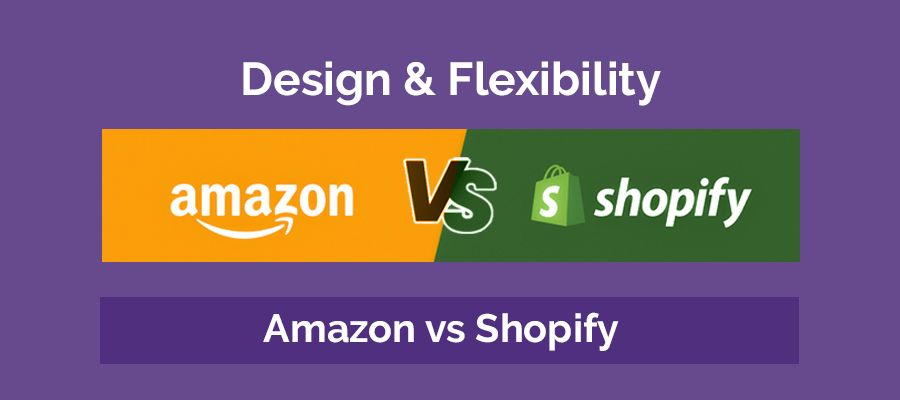
Even though powerful features in an eCommerce store are great, we cannot overlook the fact that first impressions count. That is why it is good to compare the templates of Shopify vs Amazon. It is something that you can actually see for yourself. You need to understand the design options of each platform and even look at a few examples.
-
Shopify Design And Flexibility
The templates that Shopify offers are among the most beautiful in the market. The platform has more than seventy platforms that you can select from. The only challenge about these themes is the fact that they will cost you close to $180. However, Shopify has approximately eight free themes to offer to its users.
The website builder has intuitive design features that are ideal for individuals who don’t have any coding experience. It is a doddle to make tweaks to images, buttons, and colors among other website features. You can also make straightforward HTML and CSS additions.
The main challenge with Shopify comes in when you want to make deep backend changes. You need to specialized knowledge to access and amend the backend of Shopify. The challenge with most retailers is that they don’t have this capacity.
-
Amazon Design And Flexibility
Amazon does not offer so much when it comes to the design freedom. As a seller, you can only customize a few elements of the page like the description and title, in-depth body copy and images. You cannot alter the overall page designs and layout.
After the seller registers his brand, you can also open your personal storefront which accords a higher though still limited design flexibility level. If what you need is complete control over your eCommerce store, you may need to go for a self-managed eCommerce solution such as WooCommerce or Shopify.
Ecommerce Tools & Features: Shopify vs Amazon

-
Shopify Ecommerce Tools And Features
Shopify has some of the best features that you can come across in the market. Even the free plan has features that you will pay for on another competing platform. The main ones include 24/7 award-winning customer support, use third party shipping apps to automate your fulfillment and it supports all the popular payment gateways.
Shopify also has a fully customizable blog, online store and website. The other tools include customer data, product inventory, and unlimited bandwidth. With Shopify, you can also sell on new sales channels like Amazon and Pinterest.
-
Amazon Ecommerce Tools And Features
Amazon is a platform that also has incredible eCommerce features. The main ones include email marketing integration and features, an integrated articles and blog section and custom report features and reporting tools. You will also find search engine optimized layout and code and an easy-to-use checkout. Amazon also has amazing content management capabilities. If you need these features in an eCommerce platform, you can comfortably choose Amazon and it will not let you down.
Payment Methods & Fees: Shopify vs Amazon

-
Shopify Payment Methods And Fees
You can use a credit card to make payments by utilizing Shopify payments or a 3rd party provider. Customers also have several options to make online payment without necessarily using a credit card such as Apple Pay, Amazon pay, or PayPal. The basic cost of Shopify is $29 every month with 2.9 percent plus 30c for every online transaction. The main plan for Shopify will cost you $79 every month with 2.6 percent plus 30c for each transaction. The advanced plan on Shopify costs $299 monthly with 2.4 percent plus 30c for each transaction.
-
Amazon Payment Methods And Fees
There is a long list of payment methods that are acceptable on Amazon eCommerce. These include VCB, Diners Club, American Express, Euro card or MasterCard, Amazon Secured Card, Amazon Store Card, and Visa.
If you are an individual seller, you will pay $0.99 for every item that you sell on Amazon. However, there is an additional variable fee that ranges from $0.45 to $1.35. The closing fees for professional sellers varies and the referral fee percentage ranges from 6 to 25 percent.
Pricing Plan: Shopify vs Amazon

Like the other services, pricing is favorite topic for anyone who is looking for an eCommerce platform. That is why it is important to look at the pricing of Shopify vs Amazon.
-
Shopify Pricing Plan
Shopify is a platform that will give you great value for your money. The basic package gas incredible features including abandoned cart email automation, discount codes, 24/7 support, unlimited product listings among others. It has no setup fees and you can also benefit from the 14-day free trial period. There is also a discount for those subscribe to the annual plan.
The main drawback of Shopify is the fact that it charges some extra fees when using other payment gateways others than Shopify Payments. Even though Shopify gives you several options for gateway integrations including the most popular ones like PayPal, you need to take care of the additional fees before you sign up.
-
Amazon Pricing Plan
When dealing with Amazon, the value for your money is a bit of a mixed bag. All serious sellers need to purchase subscriptions from the Amazon seller account. It has two plans with the individual plan being free even though you will be charged $0.99 when each item that you sell is collected. The second one is the professional plan that charges $39.99 per month.
These figures may not appear to be significant on the surface. However, when you narrow down to the nitty-gritty of the item fees, a more precise picture will begin to emerge. There are so many charges that the Amazon sellers have to account for that may come to 15% of the sale price of the item. Part of these costs are fulfillment fee and storage costs. All these quickly adds up and hence you need to be familiar with the fine print so that you don’t run into losses.
Conclusion
This article gives you a great comparison between Shopify vs Amazon. It is good to look at the various elements of these eCommerce platforms before making a choice. Basically speaking, the best option between these two solutions basically depends on your needs and budget. Make sure you do your homework well so that you can be able to make an informed decision.
Read Also –
- Best Portfolio WordPress Themes
- Best Multipurpose WordPress Theme
- Top Joomla Features In 2021: Complete Overview And Insights
